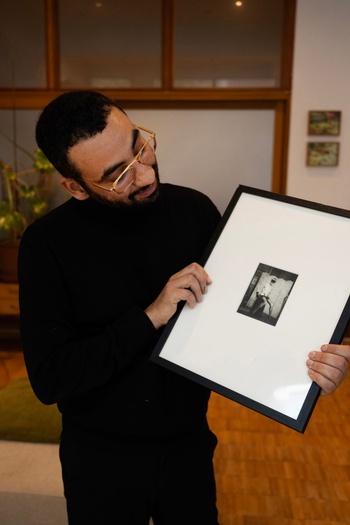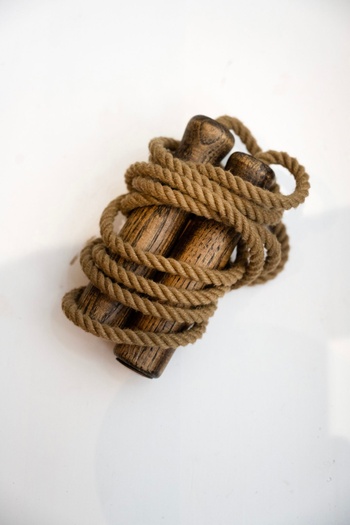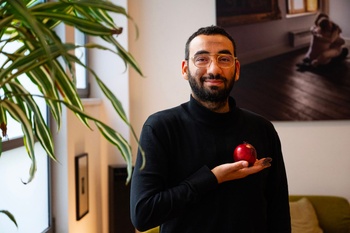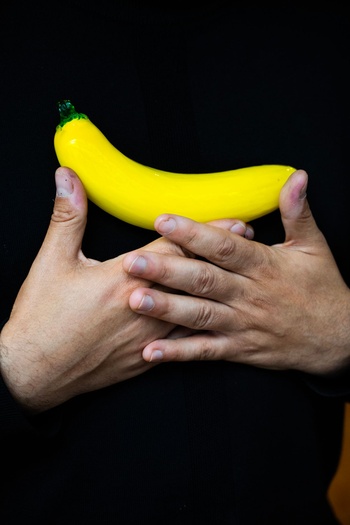On the eve of his new exhibition at De CENTRALE for contemporary art, the French-Moroccan artist Mehdi-Georges Lahlou shows us the things and materials he cherishes in his apartment in Laeken.
© Ivan Put
| Mehdi-Georges Lahlou on the pomegranate: “I show both the violence and the sensitivity of the fruit.”
Who is mehdi-Georges Lahlou?
- The French-Moroccan artist Mehdi-Georges Lahlou (40) lives and works in Paris and, since 2007, also in Brussels. His oeuvre focuses on (gender) identity, religion, physicality, conflict and geopolitics
- Launched with “sporting” performances and self-portraits, his multi-disciplinary work nowadays puts more emphasis on the materials used – such as pottery, charcoal and bronze – and their specific properties
- His new exhibition examines the representation of violence and its consequences for contemporary society. In doing so, he emphasizes the role historical and personal archives play for our collective memory Pierre Moulinier's Self-portrait

© Ivan Put
Pierre Moulinier’s Self-portrait
“When I was still a student at the Nantes art school, I was fascinated by the oeuvre of surrealists such as Hans Bellmer and Pierre Moulinier (1900-1976). I was also influenced by the feminist artists of the 1970s, such as Valie Export or Hannah Wilke, but particularly Moulinier would become an absolute reference. Certainly with regard to the use of objects that belong to the feminine, but also to the exaggeration and focus on what is outside the norm. During my student days and afterwards I made homages, but his work mainly encouraged me to do performances on the theme of gender identity.”
“I saw this self-portrait on an online sales site of a small gallery in Paris. I went to see it and instantly fell in love. Moulinier is not really a transvestite, but here he wears suspenders. Usually you see him with a mask of his wife or other women, or posing with an artificial penis. This image is unusual in his oeuvre because it is so soft and intimate.”“At that time, I could afford the photo, even though it was a serious investment as a student. But sometimes you have to do violence to your wallet so that you can be satisfied in the future. (laughs) I wanted to buy something that had a history of its own. It was also the first work of art I ever purchased. The archive has always remained an important aspect in my oeuvre, as the exhibition in De CENTRALE testifies. My work likes to start a dialogue with living artists, but sometimes also with dead ones.”

© Ivan Put
Jumping rope
“In the self-portraits of Pierre Moulinier you often see him wearing heels. With him they were black, with me they are red, a reference to my Spanish mother, who danced flamenco. This skipping rope reminds me of the cords she trained with and, like the heels, I used in a series of performances testing my body's fragility. My body as a man, but also my racialized body, because my identity consists of several layers.”
“One of my first 'sporting' performances was a 30 kilometer march that I walked in high heels between Mechelen and Antwerp in 2009. For nine hours I tried to find the right balance to arrive without too much pain. It would later turn out to be an important moment in my career, because I not only got to know the Transit gallery in Mechelen, but also Karin Renders, the then director of Art Brussels. They invited me to Art Brussels, the real start of my career.”
“I have also participated in high heel competitions on the cobblestones of the Vrijdagmarkt in Ghent. I remember a hurdle race on the mosaic tiles of Artis Den Bosch. All those achievements taught me to also take objects that form an obstacle, whether it was a march, a jump or some other sporting act that gave me a hard time.”

© Ivan Put
Pomegranate
“During my performances, I have always enjoyed crushing pomegranates with my high heels. The colour and the way the juice spread like a tableau: I loved it. The first time I used a pomegranate in a sculpture was for a huge pomegranate tree in the In Flanders Field Museum in Ypres, where curator Jan Dewilde had invited me to reflect on the notion of conflict. It was one of my first really big sculptures. I worked on it for three months. The grenade, which were then still made of a biocomposite, were painted by hand.”“Of course I was especially attracted by the double bottoms and layers of meaning of the grenade. It is a piece of fruit about which many rumours circulate. Eve probably took a bite of it in her Garden of Eden, and wasn't it the only piece of fruit that was on Noah's Ark? That it has seeds, is red and can explode is what I incorporate in my work. A grenadier is not only a fruit bush, but also a soldier. In the new bronze work 'Of the Grenadier', I examine the duality of all those meanings. The grenades on it exploded. It seems like they've opened up like some kind of disease. In their natural state, they don't look so natural. Things only go wrong in human hands. As a result, bruises appear on the fruit, as if they were real weapons. By that, I show both the violence and the sensitivity of the fruit. When you open it, something always happens.”
Charcoal
“Nowadays I work a lot with charcoal. Like everyone else, I finished my first ceramics with glaze. That was very nice. But in the end I found it more interesting to cover everything with charcoal, a much rougher material. At the expo, an antique photo suffers the same fate. She takes us to a specific moment in history: on April 22, 1915, mustard gas was used for the first time. The soldiers who were gassed near Ypres were part of a French regiment with soldiers from Normandy and Brittany, but also North Africans from the colonies. Eight years after my first work in the In Flanders Fields Museum, I returned to Ypres to find remnants from that time. In the end I came across nine photos with North African soldiers who died on that day at the front. That fact is still relevant today. Artists are also there to rename those often forgotten historical traces and look at them through a contemporary lens. That's why I changed the texture of the photo. Charcoal is dangerous and dirty, just like that first great war, a war in which soldiers died for a country that was not even their homeland. This still has consequences on a geopolitical level, for relations between the countries of the Mediterranean, as well as within the European countries that used to be the colonizers. In my work, the image from the archive almost disappears behind the charcoal, so that it becomes an exercise for the viewer to find the original photo in it.”

© Ivan Put
Banana
“I found this banana on the Vossenplein. It was presented to me by an artist friend. It is a specimen in glass, a material that has fascinated me for many years, even though I work a lot with bronze these days. I show the banana because it is an everyday object that also carries a whole history with it. Of slavery and discrimination, but also of climate change. The expo features a video installation featuring a herbarium of seven exotic plants — a banana tree, a cocoa plant, a sugar cane plant, a cinnamon tree, a maize plant, an oil palm tree, and a rice plant. Each one of them tells us something about the state of the world, because nothing is more connected to our ecology, our economy and our geopolitical decisions than our food and our fruit. By collaborating with an actress, it became an almost eco-feminist work.”
“Do you know that the palm is not a tree, but a plant that has been around for more than 100 million years and has known the dinosaur? Because we are in danger of forgetting all that, it is important for our human memory to create an archive. All the objects I have shown consist of materials that belong in those archives, from glass to coal, wood and metal to the paper of the photo I started with.”
Read more about: Expo , the stuff of life